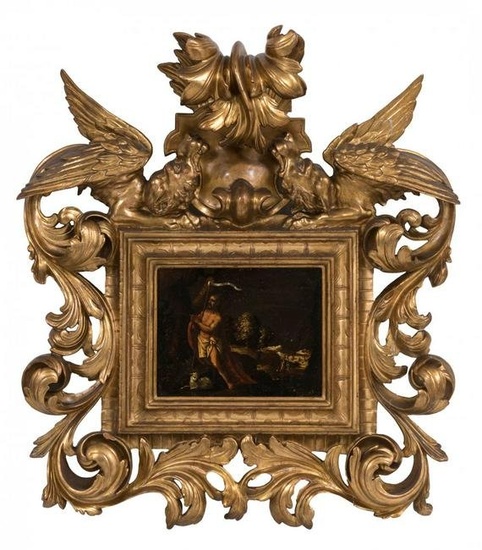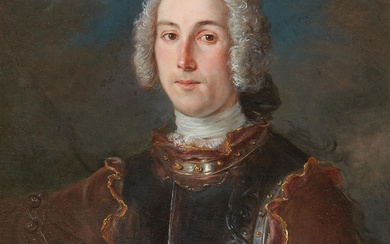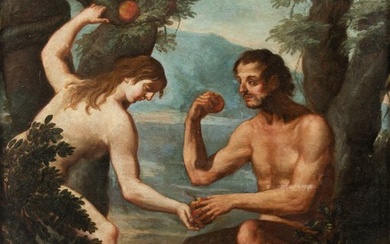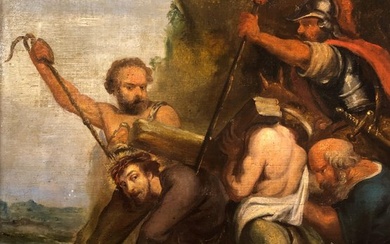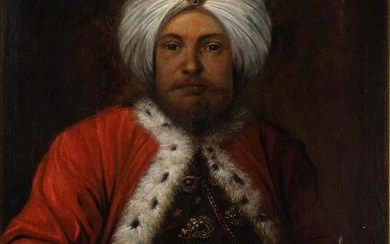Italian school; 18th Century. "Saint John Baptist". Oil on slate or obsidian. It has a 19th century
Italian school; 18th century.
"Saint John the Baptist".
Oil on slate or obsidian.
It possesses frame of the 19th century.
Measurements: 21 x 26 cm; 78 x 68 cm (frame).
Due to the technical characteristics, such as the modelling of the forms, the tonalities used, the type of composition, and even the aesthetic details used, this work can be inscribed within the Italian school. It is a devotional painting showing Saint John the Baptist penitent in the desert, standing, accompanied by the lamb and the cross of reeds. The setting follows the style of the period.
The Gospels say of John the Baptist that he was the son of the priest Zechariah and Elizabeth, cousin of the Virgin Mary. He retired at a very young age to the Judean desert to lead an ascetic life and preach penance, and recognised in Jesus, who was baptised by him, the Messiah foretold by the prophets. A year after Christ's baptism, in the year 29, John was arrested and imprisoned by the tetrarch of Galilee Herod Antipas, whose marriage to Herodias, his niece and sister-in-law, he had dared to censure. Finally St. John was beheaded, and his head given to Salome as a reward for his beautiful dances. This saint appears in Christian art in two different guises: as a child, a playmate of Jesus, and as an adult, an ascetic preacher. The adult Saint John depicted here is dressed in Eastern art in a camel-skin sackcloth, which in the West was replaced by a sheepskin, leaving his arms, legs and part of his torso bare. The red cloak he wears at times, as well as in the scene of his intercession at the Last Judgement, alludes to his martyrdom. In Byzantine art he is depicted as a large-winged angel, with his severed head on a tray which he holds in his hands. However, his attributes in Western art are very different. The most frequent is a lamb, alluding to Jesus Christ, and he often carries a cross of reeds with a phylactery with the inscription "Ecce Agnus Dei".
View it on
Estimate
Reserve
Time, Location
Auction House
Italian school; 18th century.
"Saint John the Baptist".
Oil on slate or obsidian.
It possesses frame of the 19th century.
Measurements: 21 x 26 cm; 78 x 68 cm (frame).
Due to the technical characteristics, such as the modelling of the forms, the tonalities used, the type of composition, and even the aesthetic details used, this work can be inscribed within the Italian school. It is a devotional painting showing Saint John the Baptist penitent in the desert, standing, accompanied by the lamb and the cross of reeds. The setting follows the style of the period.
The Gospels say of John the Baptist that he was the son of the priest Zechariah and Elizabeth, cousin of the Virgin Mary. He retired at a very young age to the Judean desert to lead an ascetic life and preach penance, and recognised in Jesus, who was baptised by him, the Messiah foretold by the prophets. A year after Christ's baptism, in the year 29, John was arrested and imprisoned by the tetrarch of Galilee Herod Antipas, whose marriage to Herodias, his niece and sister-in-law, he had dared to censure. Finally St. John was beheaded, and his head given to Salome as a reward for his beautiful dances. This saint appears in Christian art in two different guises: as a child, a playmate of Jesus, and as an adult, an ascetic preacher. The adult Saint John depicted here is dressed in Eastern art in a camel-skin sackcloth, which in the West was replaced by a sheepskin, leaving his arms, legs and part of his torso bare. The red cloak he wears at times, as well as in the scene of his intercession at the Last Judgement, alludes to his martyrdom. In Byzantine art he is depicted as a large-winged angel, with his severed head on a tray which he holds in his hands. However, his attributes in Western art are very different. The most frequent is a lamb, alluding to Jesus Christ, and he often carries a cross of reeds with a phylactery with the inscription "Ecce Agnus Dei".
